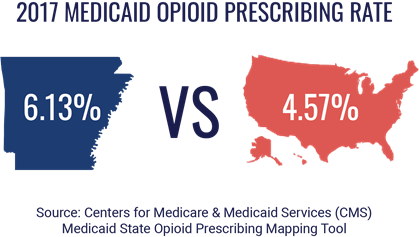
In Arkansas in 2017, the opioid prescribing rates of the Medicare Part D (6.17%) and Medicaid (6.13%) programs were higher than the national rates of 5.05% and 4.57%, respectively, according to data from the Centers for Medicare & Medicaid Services’ (CMS) interactive mapping tools — the Medicare Part D Opioid Prescribing Mapping Tool and Medicaid State Opioid Prescribing Mapping Tool.
In total, 1,124,700 Medicare Part D and 274,753 Medicaid opioid prescriptions were filled in 2017.
Launched in 2015, CMS’ original mapping tool showed a snapshot of the 2013 Medicare Part D prescribing rates. The tool has since undergone multiple updates, including the addition of the ability to compare Medicare Part D opioid prescribing rates for urban and rural areas and the inclusion of Medicaid opioid prescribing rates.
The Medicare Part D Opioid Prescribing Mapping Tool uses 2017 data from the Part D Prescriber Public Use File to show the following information at the ZIP code, county, and state levels:
- opioid and long-acting opioid prescribing rates overall
- prescribing rate changes from 2013 to 2017
- prescribing rates across rural and urban areas
- changes to prescribing rates across rural and urban areas from 2013 to 2017
- any outliers and hotspots
For the Medicaid State Opioid Prescribing Mapping Tool, 2017 Medicaid state drug utilization data collected through the Medicaid Drug Rebate Program is used to show the following information at the state level:
- opioid and long-acting opioid prescribing rates overall
- prescribing rate changes from 2013 to 2017
- prescribing rates by plan type
- changes to prescribing rates by plan type from 2013 to 2017






